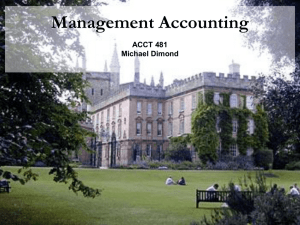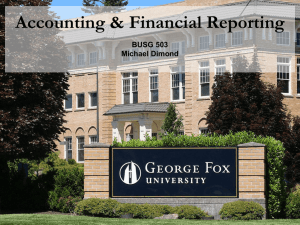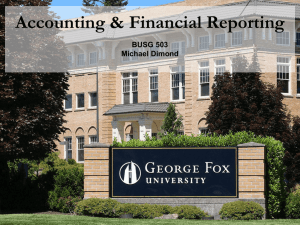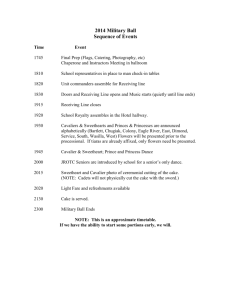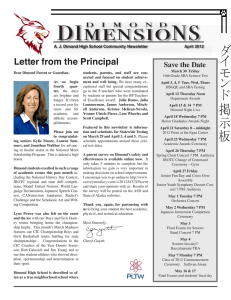Intro & Fundamentals
advertisement
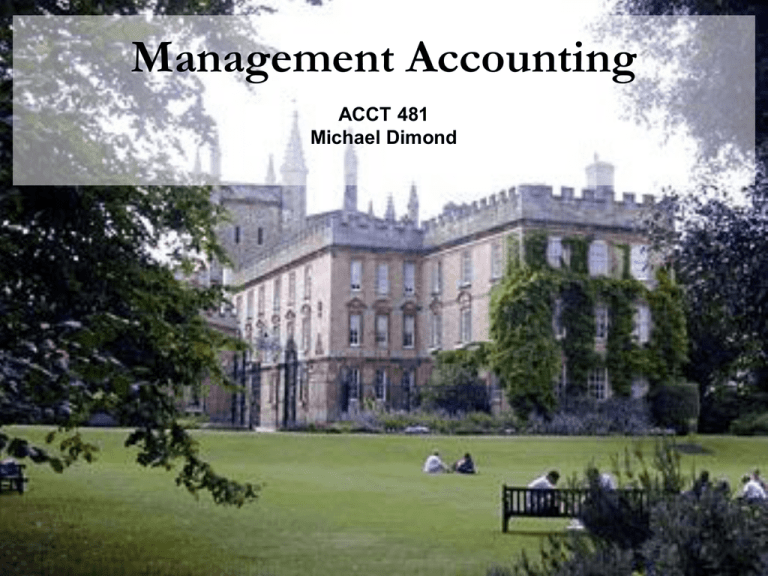
Management Accounting ACCT 481 Michael Dimond Introduction • • • • • • • • • What this class will cover Why are we here? Relevance Who am I? Who are you? Schedule Tools & Resources Please give me your preferred email address How do I get an A in this class? Michael Dimond School of Business Administration Doing Assigned Problems Michael Dimond School of Business Administration Managerial accounting is current • How does Managerial, or Cost Accounting differ from finance or accounting? • Accounting looks back to categorize, quantify & report about what happened. • Finance looks forward to future cash flows, risk and value of what we will make happen. • Managerial accounting deals with issues and decisions faced by business leaders in the present. • What types of decisions will be made? • Cost, pricing, productivity, quality, capacity and constraints are all issues addressed through managerial accounting • Planning and control are the two primary purposes of managerial accounting. • Three basic guidelines for managerial accounting: • Employ a cost-benefit approach. • Recognize technical and behavioral considerations. • Apply the notion of “different costs for different purposes.” Michael Dimond School of Business Administration Managerial acounting has a planning process • Five step decision-making process in planning and control 1. 2. 3. 4. 5. Identify the problem and uncertainties. Obtain information. Make predictions about the future. Make decisions by choosing between alternatives. Implement the decision, evaluate performance, and learn. Michael Dimond School of Business Administration The value chain can be used to optimize performance • What value does each stage contribute? Research & Development Marketing Design of Products & Processes Production Distribution Customer Service Michael Dimond School of Business Administration The supply chain can be used to optimize results • • • • Customer satisfaction Price point Timing Supply chain describes the flow of goods, services, and information from the initial sources of materials and services to the delivery of products to consumers, regardless of whether those activities occur in the same organization or in other organizations. Production Distribution Michael Dimond School of Business Administration Cost management integrates supply and value chains • Cost management needs to coordinate activities across all companies in the supply chain as well as across each business function in an individual company’s value chain. • Attempts are made to restructure all cost areas to be more cost-effective. Michael Dimond School of Business Administration Understanding costs is key to cost management • A cost object is anything for which a separate measurement of costs is desired. Examples include a product, a service, a project, a customer, a brand category, an activity, and a department • Direct costs of a cost object are related to the particular cost object and can be traced to that cost object in an economically feasible (cost-effective) way. Direct costs are traced to a cost object. • Indirect costs of a cost object are related to the particular cost object but cannot be traced to that cost object in an economically feasible (cost-effective) way. Indirect costs are allocated to a cost object. • Variable costs changes in total based on the level of activity or volume. • Fixed costs remains unchanged in total for a given time period, despite wide changes in the related level of total activity or volume. • A cost driver is a factor which causes total costs to change in a given period (e.g. sales volume). A change in the cost driver results in a change in the level of total costs. Michael Dimond School of Business Administration Example of assigning costs to cost object Michael Dimond School of Business Administration Different companies have different cost drivers • Service-sector companies provide services or intangible products to their customers, for example, legal advice or audits. • Merchandising-sector companies purchase and then sell tangible products without changing their basic form, for example retailing or distribution. • Manufacturing-sector companies purchase materials and components and convert them into various finished goods, for example automotive and textile companies. Manufacturing companies tend to have three types of inventory: • Direct materials inventory • Work-in-process inventory • Finished goods inventory Michael Dimond School of Business Administration Costs flow through the organization Michael Dimond School of Business Administration Costs on the income statement have details… Michael Dimond School of Business Administration …which come from multi-step analysis Michael Dimond School of Business Administration Manufacturing costs are analyzed in various ways Direct Materials Cost Direct Materials Cost Direct Manufacturing Labor Cost Direct Manufacturing Labor Cost Manufacturing Overhead Costs Total Mfg Costs Direct Manufacturing Labor Cost Manufacturing Overhead Costs Prime Costs Conversion Costs • How might an understanding of prime costs help a manager set a bid price if the company is above break even? Michael Dimond School of Business Administration CVP analysis helps make better decisions • Cost-volume-profit (CVP) analysis examines the behavior of total revenues, total costs, and operating income as changes occur in the units sold, selling price, variable cost per unit, or fixed costs of a product. • Breakeven analysis examines the circumstances of a company making neither a profit nor a loss. This is only part of the relationship between cost, volume, and profit. Costvolume-profit relationship is a more comprehensive term than breakeven analysis. • Breakeven units = Fixed Costs /(Priceunit – Var.Costunit) • Considerations in CVP Analysis include: • Changes in the level of revenues and costs caused by changes in the number of product (or service) units sold. • Total costs separated into a fixed and variable components. • The selling price, variable cost per unit, and fixed costs are assumed to be constant. • Scenario analysis or sensitivity analysis can be used if differing assumptions are required. Michael Dimond School of Business Administration Operating leverage is a symptom, not a cause • Operating leverage describes the effects that fixed costs have on changes in operating income as changes occur in units sold • Knowing the DOL (degree of operating leverage) at a given level of sales helps managers calculate the effect of fluctuations in sales on operating incomes. • Formulas for DOL… • %Δ Operating Income / %Δ Sales (interval estimate) • Gross Profit* / Operating Income (point estimate) • DOL is not time-based, it is condition-based. • What would DOL be at the breakeven point? *DOL computations require variable costs to determine gross profit, not direct cost. Our author avoids confusion by calling gross profit the “contribution margin” when variable costing is used. If GAAP figures are used, gross profit must have any fixed costs removed and any other variable costs added. Michael Dimond School of Business Administration Break even analysis and DOL help forecast safely • Adjusting BE for target operating income and net income • • • • • • Operating Income = (PxQ) – (VCxQ) – Total Fixed Costs Operating income = 0 at break even point BE = Total Fixed Costs / (Punit – VCunit) What if you target Operating Income = $100,000? Target volume = (Total Fixed Costs + 100,000) / (Punit – VCunit) How would you target Net Income? (HINT: adjust for interest and tax expenses) • We can also use CVP to explore scenarios, such as cost alternatives. • Safety margin • How far from our forecast can we be and still not take a loss? • Sensitivity of operating income to variance from sales forecasts • What does DOL tell us about sensitivity to sales forecasts? • What if there are multiple products? Michael Dimond School of Business Administration E2-26 Michael Dimond School of Business Administration E2-27 Michael Dimond School of Business Administration P2-30 Michael Dimond School of Business Administration P2-30 Michael Dimond School of Business Administration P2-31 Michael Dimond School of Business Administration P2-32 Michael Dimond School of Business Administration P2-32 Michael Dimond School of Business Administration E3-28 Michael Dimond School of Business Administration P3-42 Michael Dimond School of Business Administration P3-42 Michael Dimond School of Business Administration
